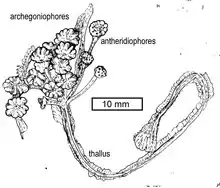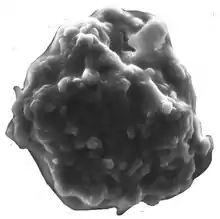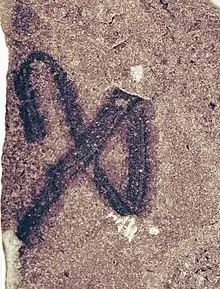Cestites
Cestites ("girdle") is a controversial fossil from the Middle Ordovician (Darriwilian, 460 million years old) Douglas Lake Member of the Lenoir Limestone from Douglas Dam Tennessee.[1] At first considered a ctenophore by Caster and Brooks,[2] it was later interpreted as a genus of liverwort by Gregory Retallack.

Thallus of Cestites mirabilis with archegoniophores

Interpretaive sketch of Cestites mirabilis

Spore of Cestites mirabilis
| Cestites Temporal range: | |
|---|---|
 | |
| Holotype of Cestites mirabilis, from Douglas Lake Member of Lenoir Limestone, at Douglas Dam, Tennessee[1] | |
| Scientific classification | |
| Kingdom: | |
| Division: | |
| Class: | |
| Order: | |
| Family: | |
| Genus: | Cestites Caster and Brooks(1956)[2] |
| Type species | |
| Casterlorum crispum Retallack (2019) | |
Description
Cestites has a narrow gametophyte thallus, with a wide midrib and dichotomizing at long intervals. The archegoniophores are parasol shaped and clustered.
Interpretation
The liverwort interpretation of this fossil has been considered controversial in some quarters [3] but accepted elsewhere.[4]
References
- Retallack, G.J. (2019). "Ordovician land plants and fungi from Douglas Dam, Tennessee". The Palaeobotanist. 68: 1–33.
- Caster, K.E.; Brooks, H.K. (1956). "New fossils from the Canadian–Chazyan (Ordovician) hiatus in Tennessee". Bulletins of American Paleontology. 36: 157–199.
- Edwards, Dianne; Morris, Jennifer L.; Axe, Lindsey; Duckett, Jeffrey G.; Pressel, Silvia; Kenrick, Paul (2022). "Piecing together the eophytes – a new group of ancient plants containing cryptospores". New Phytologist. 233 (3): 1440–1455. doi:10.1111/nph.17703. ISSN 0028-646X. PMID 34806774. S2CID 244495761.
- Leigh, Egbert (2022). "Fossil soils: trace fossils of ecosystems on land and windows on the context of evolution". Evolution Education and Outreach. 15:14: 1–5. doi:10.1186/s12052-022-00173-3. S2CID 252203727.
This article is issued from Wikipedia. The text is licensed under Creative Commons - Attribution - Sharealike. Additional terms may apply for the media files.